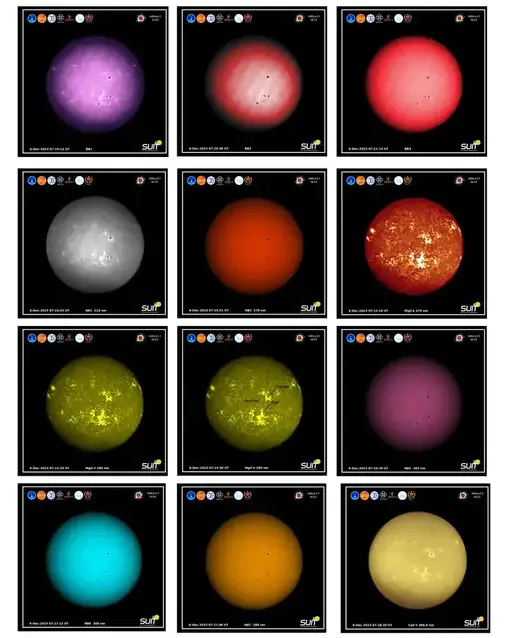In a remarkable feat, India’s first solar mission, Aditya L1, equipped with the Solar Ultraviolet Imaging Telescope (SUIT), has successfully captured the first full disk images of the Sun. Utilizing 11 filters, the telescope has intricately recorded sunspots, black spots, and the serene region of the sun.
The Indian Space Research Organisation (ISRO) shared these images on Friday (December 8), stating that the images captured by SUIT reveal the sun’s photosphere and chromosphere in critical detail.
The Aditya L1 Mission
Launched on September 2 from the Satish Dhawan Space Centre in Sriharikota, Andhra Pradesh, via the Polar Satellite Launch Vehicle (PSLV-C57), the Aditya L1 mission is now in its final phase. The mission aims to reach Lagrange Point by January 7, 2024.

Significance of the Images of Sun
The study of these images, sent by the Solar Ultraviolet Imaging Telescope (SUIT), will assist scientists in the magnetic solar atmosphere’s dynamic coupling study. This study will not only contribute to understanding the impact of continuous solar radiation on Earth but also aid in exploring ways to mitigate its effects.
Before this, on September 7, 2023, ISRO had shared images of Earth and the Moon taken from the camera mounted on Aditya L1. The photos, captured on September 4, featured the two instruments VELC and SUIT attached to Aditya L1.
Importance of Solar Studies
Our Earth is part of the solar system, with the Sun at its center. All eight planets revolve around the Sun. The Sun continuously emits energy, termed charged particles, affecting Earth. By studying the Sun, we can comprehend how the changes occurring within it can influence space and life on Earth.
What is Lagrange Point-1 (L1)?
Named after the Italian-French mathematician Joseph-Louis Lagrange, it is colloquially known as L1. There are five such points between the Earth and the Sun, where the gravitational forces of the Sun and Earth balance, creating a centrifugal force. In such a scenario, any object placed at that point begins to orbit around it effortlessly. The first Lagrange point is about 1.5 million kilometers away from Earth and the Sun.
These groundbreaking images mark a significant step in our exploration of the Sun and its impact on our planet. The scientific community eagerly awaits the revelations that further analysis of these images may unveil.
See Also: PM Vishwakarma Yojana 2023 Registration, Eligibility, Documents, Apply Online Process and Everything
Frequently Asked Questions –
1. Why is studying the Sun’s magnetic solar atmosphere important?
Understanding the Sun’s magnetic dynamics helps researchers comprehend its impact on Earth’s space environment. This knowledge is crucial for devising strategies to mitigate the effects of solar radiation on our planet.
2. How does the Aditya L1 mission contribute to solar studies?
The Aditya L1 mission captures intricate details of the Sun’s photosphere and chromosphere, providing valuable insights into solar phenomena. It aids in the study of continuous solar radiation and its potential effects on Earth.
3. What is the Lagrange Point-1 (L1), and why is it significant for space missions?
L1 is a gravitational equilibrium point between the Earth and the Sun, allowing objects to orbit effortlessly. Placing instruments like those on Aditya L1 at this point enables uninterrupted observation and data collection, enhancing the precision of space missions.
4. How far is Lagrange Point-1 from Earth, and why is it chosen for the Aditya L1 mission?
L1 is approximately 1.5 million kilometers away from Earth. The choice of this point ensures an optimal vantage point for studying the Sun, offering a balanced perspective between gravitational and centrifugal forces.
5. What potential applications can arise from the study of Aditya L1’s captured images?
The study of images captured by Aditya L1’s Solar Ultraviolet Imaging Telescope (SUIT) can aid in developing strategies to mitigate the impact of solar radiation on Earth. This research has broad implications for space weather forecasting and understanding the Sun’s influence on our planet.
Source: ISRO
Visit Homepage for latest knowledgeable blogs and latest news.







Proud to be The Bharatwasi
Thank U